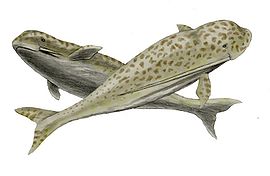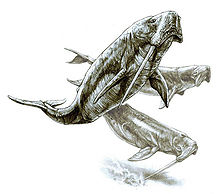- Odobenocetops
-
Odobenocetops
Temporal range: Early to Middle Pliocene
Scientific classification Kingdom: Animalia Phylum: Chordata Class: Mammalia Order: Cetacea Suborder: Odontoceti Superfamily: Delphinoidea Family: Odobenocetopsidae Genus: Odobenocetops
Muizon 1993Species - O. peruvianus (type)
- O. leptodon
Odobenocetops ("walrus-face whale") was a small whale from the Pliocene. It had two tusks, and, in some fossils, one tusk was longer than the other.
Contents
Description
Odobenocetops was an early member of the dolphin superfamily, more closely related to narwhals than dolphins, with tusks projecting towards the rear of its body. It measured about 2.1 m and weighted between 150 and 650 kg. Its neck articulations show that it was very flexible, being able to turn its head over 90 degrees. This, coupled with its broad snout, similar to that of a walrus, suggests that it was a bottom feeder, searching for mollusks and sucking them out of their shells with a powerful tongue.
Tusk use
Perhaps the most striking discovery was that of a male O. leptodon skull with a tusk significantly longer than the other. Being the only male O. leptodon skull known, it is not safe to say it was present in all male individuals of the species. Being too brittle, the tusk was probably held parallel to the body. It might have been used to search out food, or as a sensory organ like narwhal tusks. Even though they are closely related to these primitive whales, the tusks were gained by convergent evolution. The abstract of an influential article on an Odobenocetops species from the journal Nature helps to explain why this is so:
The recent discovery in the Southern Hemisphere (15.5 °S) of a walrus-like skull of a toothed whale (odontocete) from the Pisco Formation of southern Peru presents a startling example of convergence and specialization unprecedented among cetaceans. In contrast to other toothed whales, Odobenocetops peruvianus has no elongated rostrum but has large, ventrally directed premaxillary alveolar processes housing asymmetrical tusks. The dorsally facing orbits indicate the possibility of dorsal binocular vision which could compensate for the absence of the melon, a rostral organ involved in echolocation. Strong muscle scars on the anterior edge of the premaxillae suggest the presence of a powerful upper lip. It is this feature, together with the morphology of the deep vaulted palate devoid of maxillary teeth, that enables us to hypothesize a convergent feeding adaptation with the walrus which feeds mainly on thin-shelled bivalve molluscs, sucking out the foot and/or siphon and ejecting the shell. The structure of the face and basicranium indicates it was a delphinoid cetacean, probably related to the living beluga and narwhal (Monodontidae). (Muizon)
O. leptodon and O. peruvianus were extremely similar but, if the single O. leptodon is not a sport and is representative of its type, O. leptodon probably had a small melon and, therefore, echolocation ability, but had reduced (or no) binocular vision, (Muizon, et al.)[citation needed]
In popular culture
Odobenocetops was featured in the Walking With... special Sea Monsters. They were shown being easy prey for the massive prehistoric shark C. megalodon. It was identified that the species was Odobenocetops leptodon when Nigel Marvin was introducing it.[1]
References
- Haines, Tim, and Paul Chambers. The Complete Guide to Prehistoric Life. Pg. 186-187 Canada: Firefly Books Ltd., 2006.
- Annalisa Berta, James L. Sumich, Kit M. Kovacs. Marine Mammals: Evolutionary Biology. Academic Press. 2005.
- Muizon, Christian de. "Walrus-like feeding adaptation in a new cetacean from the Pliocene of Peru." Nature 365: 745 - 748. 1993.
- Muizon, Christian de, Domning, Daryl P., and Parrish, Mary. "Dimorphic tusks and adaptive strategies in a new species of walrus-like dolphin (Odobenocetopsidae) from the Pliocene of Peru [Défenses dimorphiques et stratégies adaptatives chez une nouvelle espèce de dauphin convergent vers les morses (Odobenocetopsidae) du Pliocène du Pérou]." Comptes Rendus de l'Académie des Sciences - Series IIA - Earth and Planetary Science 329(6): 449-455. 1999.
- Chased By Sea Monsters by Nigel Marven and Jasper James
See also
External links
Categories:- Prehistoric toothed whales
- Pliocene mammals
- Pliocene extinctions
- Prehistoric mammals of South America
Wikimedia Foundation. 2010.

